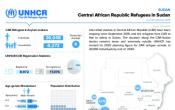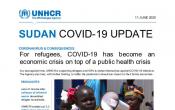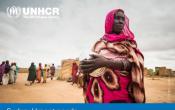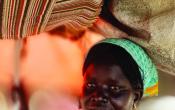Sudan
Operation: Sudan
Location
{"longitude":30,"latitude":14,"zoom_level":5,"iso_codes":"'SDN'"}
By clicking on the icons on the map, additional information is displayed.
The boundaries and names shown and the designations used on this map do not imply official endorsement or acceptance by the United Nations.
Key Figures
| 2019 year-end results | |
| 85% | of people of concern had access to health services. |
| 65% | of refugee children were enrolled in primary education. |
| 431,800 | refugees and asylum-seekers were registered on an individual basis (out of a target of 1,025,400). |
| 20,000 | refugees and asylum-seekers with specific needs received specialized support (out of a target of 74,050). |
| 2020 planning figures | |
| 115,000 | refugees and asylum-seekers registered on an individual basis with minimum set of data required |
| 114,400 | refugee children enrolled in primary education |
| 79,700 | refugee and IDP households provided with core relief items or cash grants |
| 45,000 | refugees and asylum-seekers with specific needs supported |
| 40,000 | vulnerable IDP returnees supported |
| 36,000 | Sudanese refugee returnees provided with safe and dignified returnee transport, accommodation, and cash grants, conditions permitting |
Latest Updates and Related Links
UNHCR Sudan Dashboards on Refugee Population
As of 30 September 2020
UNHCR Sudan Dashboard on South Sudanese Refugees
As of 30 September 2020
Sudan 2020 Country Refugee Response Plan
January-December 2020
People of Concern
0%
Decrease in
2019
2019
| 2019 | 2,962,701 |
| 2018 | 2,965,646 |
| 2017 | 3,323,629 |

[["Refugees",1055489],["Asylum-seekers",15545],["IDPs",1885782],["Returned refugees",2191],["Others of concern",3694]]
Loading ...
Sudan
< Back
2019
{"categories":[2015,2016,2017,2018,2019,2020],"budget":[171.32279687599998,167.16551602899997,202.25703226600004,255.89879875,268.71114289999997,274.77775777],"expenditure":[70.93360275999999,80.04125616999998,90.06267897999999,72.75113449,76.95209104999999,null]}
{"categories":[2015,2016,2017,2018,2019,2020],"p1":[137.778614176,135.018613209,167.47883553600002,218.35645491,221.49875948,224.46563100999998],"p2":[3.0773447000000003,1.54826576,2.4839356,2.0330931899999998,2.82095379,2.5766001099999998],"p3":[null,null,6.313447,11.8467486,21.949236260000003,16.68855052],"p4":[30.466838,30.598637059999998,25.98081413,23.66250205,22.442193370000002,31.046976129999997]}
{"categories":[2015,2016,2017,2018,2019,2020],"p1":[57.11940336,70.44091682,83.95294052,60.249502719999995,61.25739179999999,null],"p2":[0.56779169,0.83128585,0.98464263,0.74312904,0.90402311,null],"p3":[null,null,null,3.56043989,3.80587383,null],"p4":[13.246407710000002,8.7690535,5.12509583,8.19806284,10.984802310000001,null]}
Loading ...
CHOOSE A YEAR
- 2014
- 2015
- 2016
- 2017
- 2018
- 2019
- 2020
Operational context
The political environment in Sudan remained fragile in 2019, with the deepening economic crisis resulting in stark inflation, depreciation of the local currency, cash liquidity and fuel shortages, affecting UNHCR’s operating abilities. The situation was further exacerbated by security concerns that affected the ability of partners to operate in all locations throughout Sudan.Despite the challenging environment, Sudan continued to host over 1 million refugees and asylum-seekers, including from the Central African Republic (CAR), Chad, Eritrea, Ethiopia, the Syrian Arab Republic (Syria), and South Sudan.
UNHCR led the protection and emergency shelter and non-food item sectors for the IDP response in Sudan, working closely with the child protection, sexual and gender-based violence (SGBV), and mine action sub-sectors.
Population trends
In addition to the over 1 million refugees and asylum-seekers residing in Sudan in 2019, a further 1.9 million people were estimated to be internally displaced.The large majority of refugees (some 815,000) were of South Sudanese nationality, with large populations of Eritreans (121,000) and Syrians (94,000) residing in South and Central Darfur and Khartoum States respectively. Refugees and asylum-seekers from Ethiopia, the CAR, Chad and Yemen also constituted considerable populations of concern.
Key achievements
- UNHCR strengthened its interventions in the areas of SGBV, child protection, and civil documentation. This was accomplished through new partnerships and enhanced internal capacity.
- UNHCR worked to expedite the registration of new arrivals, verification, proGres v.4 roll-out, documentation, and systematic use of the Global Distribution Tool.
Unmet needs
With the operation only 32% funded for 2019, the level of basic service provision was consequently limited.- Less than 50% of women and girls received sanitary materials.
- Only 42% of refugees were registered on an individual basis with the minimum set of data required.
- A mere 27% of refugees and asylum-seekers with specific needs received specialized support.
- Less than 1% of shelters were constructed with environmentally sustainable shelter materials.
- Only 1% of SGBV survivors received psychosocial counselling.
Operational Environment
Despite some positive developments in Sudan, recovery from decades of conflicts remains challenging. The easing of economic sanctions in 2017, if sustained, could bring economic improvement for both refugee and local communities, albeit a series of economic reforms are prerequisite, including for access to the development funding. Inflation has culminated in a 100 per cent increase in cost of living, which has a detrimental impact on the entire local and refugee population.The political dimension of the South Sudan crisis remains unresolved. As a result of continued localized fighting, limited humanitarian assistance and extreme levels of food insecurity driven by conflict, South Sudanese refugees, mostly women and children, will continue to cross into Sudan seeking safety, access to food and basic services. It is left to be seen how the Revitalised Agreement on the Resolution of the Conflict in South Sudan signed on 12 September 2018 will impact this trend going forward.
The situation in Syrian Arab Republic and Yemen is likely to remain fluid, with continuous small scale arrivals of refugees to Sudan.
In addition, Sudan remains a source, transit and destination country for irregular movements including asylum-seekers and refugees using the East African North-bound migratory route through Libya to Europe.
A small number of Chadian refugees is expected to remain in Darfur after the voluntary return of the majority in 2017 and 2018 is completed. On the other hand, and in the absence of prospects for sustainable return, the number of refugees from the Central African Republic (CAR) in Sudan is expected to remain unchanged.
Furthermore, significant spontaneous returns and UNHCR-assisted voluntary returns of Sudanese refugees from Chad are expected to continue particularly to North, Central and West Darfur States.
The Commission for Refugees will remain UNHCR’s primary Government counterpart in protection, registration, camp management and overall coordination of the refugee response in 2019, while continuous strengthening of coordination with line ministries, including Ministries of education, health and social affairs will remain UNHCR’s priority. In terms of statelessness, UNHCR will continue partnership with the Sudanese Civil Registry, and maintain close cooperation with Ministries of Interior and Foreign Affairs.
UNHCR will continue to foster partnerships and coordination with authorities to address mixed and onward movements, including with the Ministry of Interior, National Committee to Combat Human Trafficking and the State Committee to Combat Human Trafficking.
The Refugee Consultation Forum (RCF) will remain the main, high-level coordination forum for all refugee situations within Sudan, whether undertaken in camp, rural or urban settings, or for new or protracted operations. As the Protection Cluster Working Group lead, UNHCR will continue to share information and coordinate protection response activities, including coordinate the work of over 40 NGO partners as the Emergency Shelter/NFI sector-lead.
UNHCR will continue to lead RCF’s participation in the Humanitarian Response Plan and the Multi-Year Humanitarian Strategy (MYHS) processes led by OCHA to ensure representation of refugee needs as a distinct but integrated component of the inter-agency planning process. Sudan is a pilot country for the New Way of Working, and UNDAF is also considered within the context of the inter-agency MYHS. Increased attention on mixed movements will necessitate greater inter-agency engagement and advocacy, and UNHCR will lead a strengthened inter-agency focus on migration issues.
Key Priotities
In Eastern Sudan, access to territory for Eritrean, Ethiopian and Somali refugees will continue to be ensured through regular border and reception conditions’ monitoring, including through liaison and advocacy with border authorities. UNHCR will also monitor detention facilities and intervene to prevent forcible returns and conduct advocacy on statelessness, including training and capacity-building on international refugee law. Together with the Government and other stakeholders, UNHCR will continue working on consolidation of camps in Eastern Sudan to achieve social cohesion and integration with host communities. While the focus will be on promoting self-reliance, new arrivals will continue to receive assistance.For South Sudanese refugees, UNHCR will work with the Government to gradually mainstream services into national systems, education and WASH related services in particular. Small scale livelihoods projects benefiting both refugee and host communities will be implemented, and construction of durable shelters will be prioritized. The operation will expand cash-based interventions to prioritize support under NFI, shelter, livelihoods, energy and education sectors. Protection of women and children will be a priority as will be the strengthening of the community-based protection services for unaccompanied and separated children (UASC) and other vulnerable groups.
In order to ensure sustainable return and reintegration of Sudanese refugees from Chad, UNHCR will work within the existing coordination structures, including the Durable Solutions Working Group and Return, Recovery and Reintegration Sector, to improve access to basic services and enhance rule of law in return areas. As returnees have indicated water and health as two highest priorities, UNHCR will support rehabilitation and construction of health and water facilities in addition to community-based protection projects that will benefit both return and host communities.
The urban refugee protection strategy will prioritize enhancing protection mechanisms for extremely vulnerable individuals, including women at risk, victims of trafficking and UASC; promotion of employment opportunities as a means of attaining self-reliance and expanding access to services through local community-based structures and enhanced community outreach. Legal aid will continue to be provided to ensure urban refugees have adequate legal representation, particularly where matters are tied to the individual’s asylum status in Sudan.
In light of the current active law reform efforts reflected in the recent adoption of an important amendment to the Nationality Act (February 2018) which, once enforced, will contribute significantly to the reduction of the risk of statelessness for a considerable number of people, UNHCR will prioritize and increase activities aiming at supporting law reform through both advocacy and technical capacity building.





























